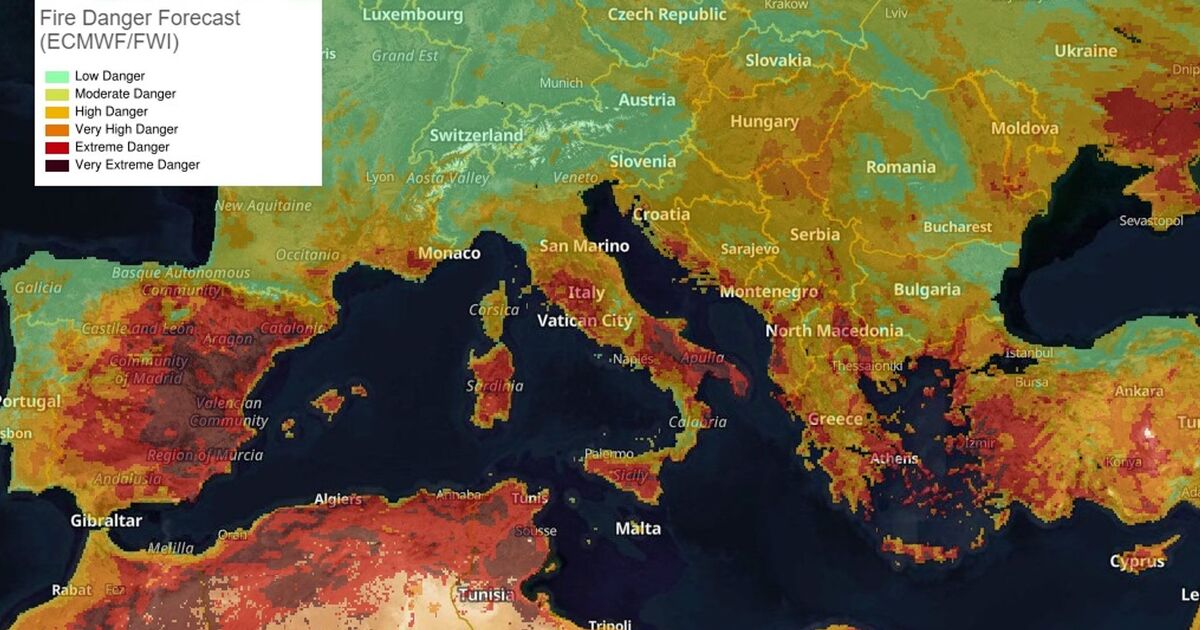The risk of wildfires across most of southern Europe, including the most popular holiday destinations including Spain, Portugal, Italy and Greece has been declared as high or extreme by authorities.
Fire danger maps have turned shades of dark orange and red across much of the continent.
This new danger comes as the heatwave in the southwest of Europe is also set to spread eastwards towards more holiday hotspots.
Areas most at risk are eastern Spain, the south of Italy and parts of Greece, which have turned a worrying black on maps produced by the EU’s European Forest Fire Information System (EFFIS).
Residents and visitors near a fire have been ordered to evacuate the Greek island of Evia, near Athens, while Albanian firefighters are battling a blaze at the seaside town of Shengjin. Likewise in Sardinia, planes and helicopters are continuing to fight a fire which broke out on Tuesday evening, which now extends as much as 4.3 miles.
On Monday, an elderly gentleman was killed in a forest fire which has been burning in North Macedonia since the start of the month.
The Greek Prime Minister, Kyriakos Mitsotakis, said his country had been grappling with a “very difficult summer” while warning the country must remain on high alert for August, which is set to continue the worrisome trend.
While the risk of fires is high, actual outbreaks are currently contained in small areas.
The current situation is not helped by the fact that the grass is parched, after most of Europe saw above-average temperatures throughout spring and early summer, making it incredibly easy for forests and grassland to catch alight.
In recent weeks, British tourists preparing for holidays in Spain, Italy and Greece have been warned of temperatures exceeding 40C in some areas. Last week, the Met Office issued a warning of temperatures as high as 46C in certain areas of Spain, Portugal and Morocco.
As for this week, Brits descending on Majorca and Malaga have been warned to expect temperatures in the high 30s, while Portugal’s Algarve is set for 38C. Elsewhere in Spain is expected to hit 40C again.
Those off to watch the Olympics in Paris can expect unseasonably high temperatures of 36C, about 10C above the average for this time of year.
Temperatures in the low- to mid-40s are on course to reach Romania, Bulgaria and Greece later this week, with daytime temperatures also about 10C above the expected averages for early August.
Sky’s weather producer, Joanna Robinson, described Europe’s summer heat as “relentless” and warned that the above-average temperatures could extend north at times as well.
Such high temperatures have produced another issue, as a concerning amount of EU land has been forced into early or later stages of drought – about a tenth, or 16 percent. Sicily has been badly affected, with it declaring it the worst crisis to hit the Italian island in 30 years. Only 150 millimetres of rain fell in the second half of 2023. As a result, an Italian navy tanker has shipped 12 million litres of water to the worst affected areas.
Other areas badly impacted include southern Italy, northwest Spain, Greece and central-western Turkey, resulting in parched crops and countryside stripped of greenery.
While the amount of land in drought remains much less than the nearly half affected by the very hot summer of 2022, the EU’s European Drought Observatory warned that most of the Mediterranean region is “yet to recover”.
Scientists have said that while heatwaves and fires existed before climate change, hotter global temperatures can make them worse. One study found that the drought of 2022 was made 20 times more likely by climate change.











